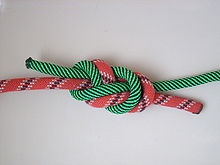Flemish bend
Appearance
This article needs additional citations for verification. (June 2017) |
| Flemish bend | |
|---|---|
 | |
| Names | Flemish bend, figure eight bend |
| Category | Bend |
| Related | Figure-eight knot |
| Typical use | Climbing |
| ABoK | #1411 |
The Flemish bend, also known as a figure eight bend, a double figure eight bend, and a rewoven figure eight is a knot for joining two ropes of roughly similar size.
A loose figure-eight knot is tied in the end of one rope. The second rope is now threaded backwards parallel to the first rope. When properly dressed, the two strands do not cross each other.
Although fairly secure, it is susceptible to jamming. If tied, dressed and stressed properly it does not need "stopper" or "safety" knots.
The Flemish bend, also called figure-eight bend, is often given in knot monographs but is seldom used. It is bulky and bothersome to tie, and not to be preferred to the following knot [ water knot ], which is made in a similar manner.
See also
References
- ^ Ashley, Clifford W. (1944). The Ashley Book of Knots, p.258-59. Doubleday. ISBN 0-385-04025-3.
External links
- Flemish, or double figure eight, bend animated video by Marinews
- Grog. "Flemish, or figure eight, bend". Animated Knots. Retrieved April 2013.
{{cite web}}: Check date values in:|access-date=(help)

